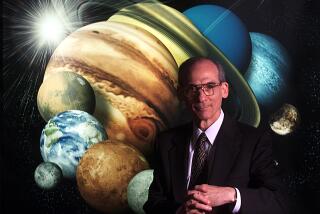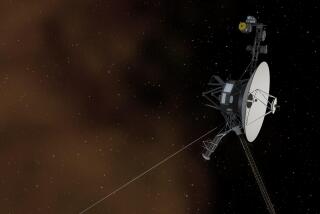‘Our Message to the Milky Way’
- Share via
“Hello, from the children of planet Earth!”
Someday, these friendly words might greet beings from another world!
No one knows whether life exists anywhere else but Earth. Even if it does, no one knows whether any alien life forms might be intelligent. Or whether they might be advanced enough to have space travel.
But, what if . . . ?
Let’s go back to 1977. The United States launches two robotic spacecraft. Robotic means they have no people in them. The spacecraft are named Voyager 1 and Voyager 2. They are going to explore the outer planets of our solar system. As they fly past, they study Jupiter and Saturn. Voyager 1 then heads in a different direction and keeps going. Voyager 2 goes on to Uranus and Neptune. Then it too keeps on going.
Voyagers’ builders made these to travel far, far from the sun. The builders hope the spacecraft will one day find the very edge of the solar system. That’s where the solar wind meets the interstellar wind. The solar wind is the constant blast of particles from our own star, the sun. The interstellar wind is the blast of particles from other stars.
At that boundary, the Voyagers will become the first interstellar travelers from Earth -- or maybe from anywhere. No one knows.
But, what if -- somebody -- or something -- someday finds one of our Voyagers out there?
Well, a few years before 1977, one of those asking “what if” was a man named Carl Sagan. Sagan was a famous astronomer. He loved to share his excitement and wonder about the cosmos. He made a TV series called “Cosmos.” He loved to say, “We are star stuff.” Then he would explain why that statement was true.
Sagan did not care how unlikely it was that anyone would ever find the Voyagers. He and many others wanted the spacecraft to carry a message from Earth. They formed a team to create such a message. They wanted to show and describe who we are. They wanted to say where we are, how we live and what we have accomplished. They wanted to write a message that anyone could understand, no matter what language they spoke.
They gathered sounds and images of Earth. They gathered the sounds of surf, birds, human speech and human technology. They gathered pictures of rivers and mountains and deserts. They gathered pictures of people of all kinds and cultures.
They used the languages of science and math to tell when the spacecraft was launched, what gases compose Earth’s atmosphere and other precise information about our world.
They recorded all this information on a golden record. This record is somewhat like an old vinyl record. The listener places a needle on the record and “plays it.” The golden record is very much like this. It has a golden cover that shows how to play it.
It is unlikely we or our children or grandchildren will ever know whether anyone has received our message. But we do know that the two Voyagers are still going, still communicating with Earth, 32 years after their launch. We also know that they are only just now reaching the edge of our own solar system.
Soon the Voyagers will be the first interstellar travelers from Earth. Will they also be our first galactic ambassadors?
Want to hear some of the sounds and see some of the pictures carried on the golden records?
Visit spaceplace.nasa.gov/en/kids/
This article was provided by the Jet Propulsion Laboratory, California Institute of Technology, under a contract with the National Aeronautics and Space Administration.
More to Read
The biggest entertainment stories
Get our big stories about Hollywood, film, television, music, arts, culture and more right in your inbox as soon as they publish.
You may occasionally receive promotional content from the Los Angeles Times.










